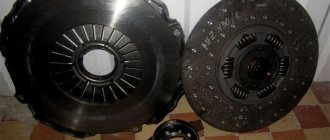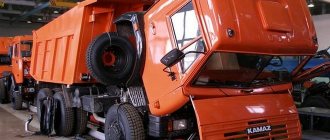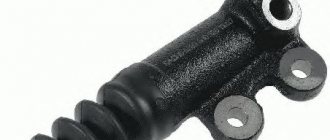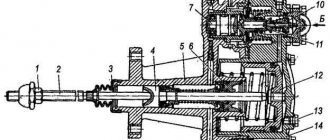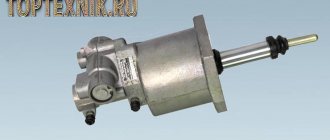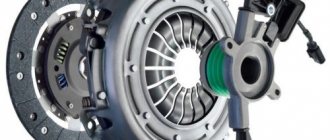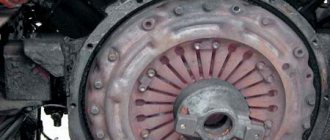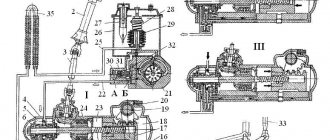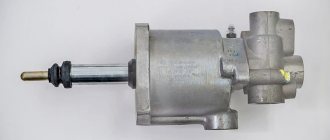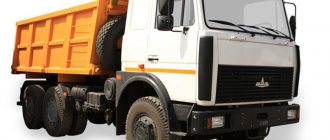Types of clutch
There are many options for clutches. Mechanics distinguish the following types of car clutch:
- on the working surface - dry and wet;
- according to the number of clutch discs - 1-disc, 2-disc and multi-disc;
- by type of drive - friction, hydraulic and combined (the electromagnetic type is a subtype of the friction type);
- according to the impact on the pressure plate - using one diaphragm spring or several cylindrical springs.
Of course, each mechanism option has its pros and cons. But modern cars most often use a single-plate dry clutch with a mechanical or hydraulic drive.
Synopsis-concatenation lesson plan-summary on the topic
Purpose and types
A clutch is a power coupling in which the transmission of torque is provided by frictional forces, hydrodynamic forces or an electromagnetic field. Such clutches are called friction, hydraulic and electromagnetic, respectively.
The clutch serves to temporarily separate the engine and transmission and smoothly connect them. Temporary separation of the engine and transmission is necessary when changing gears, braking and stopping the car, and a smooth connection is necessary after changing gears and when starting the car. When the vehicle is moving, the clutch, when engaged, transmits torque from the engine to the gearbox and protects the transmission mechanisms from dynamic loads occurring in the transmission. Thus, the loads in the transmission increase during sharp braking with the engine, abrupt engagement of the clutch, uneven engine operation and a sharp decrease in the crankshaft speed, wheels running over uneven roads, etc.
Various types of clutches are used on cars (diagram 1).
Scheme 1 – Types of clutches classified according to various criteria.
All of these clutches, except centrifugal ones, are permanently closed , i.e. constantly turned on and off by the driver when changing gears, braking and stopping the car.
Friction clutches are most widely used in cars . Single-plate clutches are used on light- and medium-duty and sometimes heavy-duty passenger cars, buses and trucks.
Double-disc clutches are installed on heavy-duty trucks and large-capacity buses.
Multi-disc clutches are used very rarely - only on heavy-duty vehicles.
Hydraulic clutches, or fluid couplings, are not used as a separate mechanism on modern cars. Previously, they were used in car transmissions, but only in conjunction with a friction clutch installed in series.
Electromagnetic clutches had some use on cars, but were not widely used due to the complexity of their design.
Clutch requirements
One of the main indicators of clutch is its ability to transmit torque. To evaluate it, the concept of the value of the clutch safety factor ß , defined as follows:
ß = MSC / Mmax
where MSC is the maximum torque that the clutch can transmit,
Mmax – maximum engine torque.
In addition to the general requirements relating to each component of the car, a number of specific requirements are imposed on the clutch, including:
1. Smooth start . In operation, it is ensured by qualified control, but some design elements are designed to improve the smoothness of clutch engagement even with low driver qualifications.
2. Clean shutdown . Absolute disengagement, in which the torque on the clutch output shaft is zero, is difficult to achieve, but if the torque transmitted by the disengaged clutch is small enough and does not interfere with the engagement of gears, then we can assume that such a clutch is disengaged almost cleanly.
3. Reliable torque transmission under all operating conditions . Too low a value of the safety factor leads to increased clutch slipping time when starting the vehicle (especially in difficult operating conditions), increased heating and wear. An excessively large value of the safety factor is accompanied by an increase in the size and weight of the clutch, an increase in the force required to control it, and a deterioration in the protection of the transmission and engine from overloads. Typically, the value of the clutch reserve coefficient is 1.4 - 1.7 for cars and 1.5 - 2.0 for trucks, increasing to 2.3 for heavy tractors.
4. Minimum value of the moment of inertia of the driven parts . Violation of this requirement will not affect the performance of the clutch’s functions, but will lead to a lengthening of the gear shifting process and a reduction in the service life of the gearbox synchronizers.
5. Ease of management . This requirement, common to all controls, is specified in the form of requirements for the pedal stroke and the force required to press it. The current restrictions in Russia are 150 N of force for cars with clutch drive amplifiers, and 250 N for cars without amplifiers. Pedal travel is usually no more than 160 mm.
Typical clutch device - single-disc, friction
A friction clutch is a disc clutch in which torque is transmitted by dry friction.
Single-plate dry clutches are widely used on modern cars. A single-plate clutch is a friction clutch in which one driven disc is used to transmit torque.
A single-disc clutch (diagram 2, a) consists of driving and driven parts , as well as parts for engaging and disengaging the clutch.
Scheme 2 – Single-plate friction clutch
a – enabled; b – off; 1 – casing; 2 – pressure disk; 3 – flywheel; 4 – driven disk; 5 – plate; 6 – spring; 7 – bearing; 8 – pedal; 9 – shaft; 10 – traction; 11 – fork; 12 – lever
The driving parts are the engine flywheel 3, the casing 1 and the pressure plate 2, the driven parts are the driven disc 4, the switching parts are springs 6, the switching parts are levers 12 and the clutch with bearing 7.
Housing 1 is bolted to the flywheel. The pressure plate 2 is connected to the casing by elastic plates 5. This ensures the transmission of torque from the casing to the pressure plate and the movement of the pressure plate in the axial direction when the clutch is engaged and disengaged. The driven disk 4 is installed on the splines of the primary (drive) shaft 9 of the gearbox.
The clutch has a drive, which includes a pedal 8, a rod 10, a fork 11 and a clutch with a release bearing 7.
When the pedal 8 is released, the clutch is engaged, since the driven disk 4 is pressed to the flywheel 3 by the pressure disk 2 by the force of the springs 6. The clutch transmits torque from the driving parts to the driven ones through the friction surfaces of the driven disk with the flywheel and the pressure disk. When you press pedal 8 (diagram 2, b), the clutch disengages, since the clutch with the release bearing 7 moves to the flywheel, turns the levers 12, which move the pressure disk 2 away from the driven disk 4. In this case, the driving and driven parts of the clutch are separated, and The clutch does not transmit torque.
Single-disc clutches are simple in design, cheap to manufacture, reliable in operation, provide good heat removal from rubbing surfaces, clean disengagement and smooth engagement. They are easy to maintain during operation and repair.
In single-plate clutches, the compression of the driving and driven parts can be carried out by several cylindrical springs evenly spaced along the periphery of the pressure plate. It can also be carried out by a single diaphragm spring or a conical spring mounted in the center of the pressure plate.
Clutch with peripheral springs is somewhat more complex in design (large number of springs). In addition, the breakdown of one of the springs may not be noticed during operation, which will lead to increased wear of the clutch.
A clutch with one central spring is simpler in design and more reliable in operation. With a central diaphragm spring, the clutch has a smaller mass and overall dimensions, as well as a smaller number of parts, since the spring, in addition to its function, also serves as a clutch release lever. In addition, it ensures even distribution of force on the pressure plate. Clutches with a central diaphragm spring are used in passenger cars due to the difficulty of producing springs with high pressure force with small overall dimensions of the clutch.
A clutch with a central conical spring has the advantage that the pressure spring does not come into contact with the pressure plate and therefore heats up less when the clutch operates and retains its elastic properties longer. In addition, thanks to the design of the pressure mechanism, the clutch can transmit high torque with a relatively small spring force. Such clutches are used on heavy-duty trucks.
Clutch drives
Friction clutch drives can be mechanical, hydraulic and electromagnetic. Mechanical and hydraulic drives are most widely used in automobiles.
Mechanical drives are simple in design and reliable in operation. However, they have lower efficiency than hydraulic clutch drives.
Hydraulic drives , having greater efficiency, provide smoother clutch engagement and reduce the force required to disengage the clutch. But hydraulic drives are more complex in design and maintenance, less reliable in operation, more expensive and require greater maintenance costs during operation.
To facilitate clutch control, drives often use mechanical amplifiers in the form of servo springs, pneumatic and vacuum. Thus, servo springs reduce the maximum clutch release force by 20...40%.
Driven disc, clutch basket and flywheel.
The clutch of a car is a very important element that bears a large load. The choice of clutch mechanism depends on the engine power and torque. The most common option is an inexpensive single-plate clutch with a simple design with organic linings on the driven disc; it is used on 95% of cars with a manual transmission. The principle of operation is as follows: the driven disk is clamped by two drive disks (the role of which is played by the flywheel and clutch basket) and energy is transferred from the engine to the wheels. Organic materials do not like high temperatures, and are designed for use in calm conditions, without excessive loads. In case of sudden starts or off-road driving, the organic disc heats up and begins to smoke. Everyone has probably encountered such a situation in some kind of off-road rut, when, when trying to get out of the mud, a characteristic smell of “burnt clutch” appears. At the same time, its resource is reduced very sharply; one can say several such situations, and the clutch disc will begin to slip. For example, when accelerating sharply or going uphill, you will feel that the engine is gaining momentum, but the car is not moving. This means it’s time to change the clutch driven disc, the procedure is not easy, it involves removing the box. Overheating of the disc can also cause detachment of the friction linings, and it will not “slip”, but “drive”, that is, when fully squeezing, the gears are difficult to engage. In motorsport, the clutch is subject to a large load, as gear changes are carried out in the range of 6000-10000 rpm at maximum engine power. The standard clutch cannot withstand such loads and is being replaced with a more reliable design. The easiest way is a basket with increased downforce by 30, 50 or even 100%. This clutch firmly holds the driven disc, but has its drawbacks. The force on the clutch pedal increases, which worsens gear shift speed. In addition, on front-wheel drive VAZs, squeezing occurs using a cable, which can break under excessive loads. In such cases, a hydraulic clutch release drive is installed.
Instead of organics, ceramics, carbon and Kevlar are also used as friction materials . Let's consider the use of each material in more detail. Ceramics : does not heat up and can withstand heavy loads. But more “slippery” compared to other types of friction linings. Requires high basket downforce. It switches abruptly from the “off” state to the “on” state. Carbon : has a higher coefficient of friction than ceramic, resulting in smoother shifting. It is light in weight, has a longer service life and is resistant to overheating. Kevlar : used in aviation and body armor. Wear resistance is 5-10 times higher than that of organic materials. It tolerates heat well, but takes a long time to cool down and can heat up the driven discs. Has a low coefficient of friction, like ceramics. The driven clutch discs can be with or without a spring damper (the central part of the disc). The spring damper is used on all standard cars, softens shock loads, causes less noise and vibration, but is not intended for heavy loads. Springless discs are lightweight and provide crisp, quick gear shifting. They have a shorter spline life due to shock loads. Only used in motorsport.
Flywheel.
On cars that require fast acceleration, it makes sense to use a lightweight flywheel, as well as the entire crank mechanism. Reducing the mass of rotating engine parts by 10 kg during acceleration has the same effect as reducing the mass of a car by 100 kg. Light flywheels are not recommended for engines that operate at low speeds: diesel engines, SUVs. High-speed motors used for rapid acceleration should be as light as possible in rotating mechanisms, but not at the expense of strength. The flywheel, crankshaft and pistons with connecting rods must be balanced to avoid destructive vibration loads.
Multi-disc clutch.
When the capabilities of a single-disc clutch have been exhausted, it is replaced by a multi-disc clutch. Its coefficient is multiplied by the number of discs, and it is not necessary to have a basket with high downforce. Driven disks are usually used without springs to facilitate the design. The operating principle of the device is the same as that of a conventional clutch, but instead of one driven disk, two or more are used. The number of leading disks also increases. In addition to the flywheel and pressure plate in the basket, between the driven disks there is also a drive disk, which moves freely along the axis of rotation, but is hooked to the basket and rotates with it. Such mechanisms are used on all high-performance racing cars, for example, on Formula 1 bollids, a four-disc clutch. There are two-disc kits for VAZ drag cars.
dual clutch
Reading car reviews in recent years, you can often see a gearbox with two clutches in the description, and the tricky names of these gearboxes are often indicated. And it already seems that there is nothing new in this, but few of the readers, and what readers, not every automotive specialist mechanic will be able to clearly explain how it is and what it is. Meanwhile, manufacturers have put a lot of effort into creating such a gearbox, and it certainly makes a lot of sense. How does this dual clutch box work? This article will answer this complex question in detail and simply.
It’s worth immediately introducing an understanding of what new and better this box gave. The double clutch makes the movement as smooth as possible, without jerking, which means for many it is a safe start to the movement, in addition, it saves fuel. As a disadvantage of such an innovation, it is worth noting that there are a lot of new and complex mechanical elements and components. And since they are located in the clutch and torque transmission system, repairs will cost a pretty penny, plus not every mechanic will undertake such repairs.
How it was
The double clutch initially appeared in racing cars and did not take root in mass production of cars for a long time due to the complexity of the design and price. Surprisingly, the distant ancestor of the modern double clutch was the mechanism that Adolphe Kegresse planned to install on the Citroen Traction racing car back in 1939. Perhaps the war interrupted these developments and the clutch remained on the drawings. At the end of the 20th century, manufacturers and designers of the legendary Porsche began to think about bringing this idea to life. As a result, a gearbox was created that made it possible to change gears without releasing the gas; the result was a unique mechanism of its own. After all, if you take into account a racing car and competitions, then every second counts, and such a gearbox saved a lot of time. Any car, when switching and releasing the gas, loses a lot of power, and therefore speed, which then has to be actively gained, costing time and fuel.
How does a dual-clutch transmission work?
The main innovation in such a box is a double shaft. In the standard version, the manual transmission has one shaft and gears that cling to it; in the new version, the task of the first clutch is to transmit torque to the external shaft, i.e. all even passes. The second clutch transmits torque to the inner shaft, engaging odd gears. If you look at it open, you will see two mechanical boxes in one box that work successfully together, but alternately.
To control such a box, two systems were added - hydraulic and automatic, but there is no torque converter, which is installed in a conventional automatic transmission. According to the type of mechanism, double-clutch transmissions are of two types: dry type, and wet type, when the components and mechanisms are in oil. The DSG dual clutch system is recognized as the most efficient and advanced of the dry dual clutch types.
How it works
As usual, you start at minimum speed in first gear, and the automatic part has already prepared second gear for you. Now, when switching to second gear, the first gear on the first shaft is reset, and the second on the second shaft, regardless of the first, immediately turns on. Now that second gear is already engaged, third gear is automatically prepared.
The automation, which is responsible for preparation and switching, is designed in a very interesting way; during preparation it takes into account a number of points:
- what position the accelerator is in, there are two options: either it accelerates, or when released it slows down;
- controls the speed of disk rotation;
- at what speed do the transmission shafts rotate;
- The position of the gear lever is taken into account.
There is such a short period of time during which literally for hundredths of a second both clutches are in a closed state. At the same time, the engine is still in engagement with the drive wheels, so there is no loss of torque, and the speed and power do not drop. This may be why the dual clutch is called a semi-automatic transmission, although this is not entirely true.
As mentioned above, these are two manual transmissions, but together they work in such a way that a clutch pedal is not required. A huge advantage of changing gears is that it can be done manually, as the driver usually does, or using a computer and buttons located on the steering wheel.
Pros of dual clutch
- the movement becomes very smooth, there are no jerks or sudden starts, especially as happens with a manual transmission;
- There is no loss of power when switching, this is due to linear acceleration;
- fuel is saved significantly, even compared to an automatic transmission, fuel consumption is 10% less due to the absence of the need to slow down and then accelerate to pick it up;
- as already mentioned, the speed can be switched manually or using a computer;
- for cars with powerful engines over 200 l/s, this is simply an irreplaceable thing.
Negative points
- the double clutch device is complex, you will have to spend a lot of money on repairs;
- in addition, it is difficult to find a good specialist, because although the technology has been developed for quite a long time, you can’t find them very often here, the services work the old fashioned way - manual transmission and automatic transmission;
- When driving too actively, jerks or dips may occur due to sudden braking or acceleration. A dual-clutch transmission needs time to process the data received from all nodes and make a decision, and this is about 400-600 milliseconds. If your mode is even faster, then the effects described above will be noticeable.
Volkswagen began installing direct shift gearboxes back in 2003; to this day they are called Direct Shift Gearbox; the first gearboxes were six-speed. But now 7-speed DSGs are installed on new generation cars.
The dual-clutch transmission has absorbed all the best from manual and automatic transmissions; minimal fuel consumption is clearly noticeable here with a very smooth and comfortable ride of the car. But, of course, nothing is ideal and you can find disadvantages in everything.
Today, almost all leading auto manufacturers install dual-clutch gearboxes on their new vehicles. This can be seen from reviews of such cars as: BMW, Ford, Chrysler, Audi, Volvo and many others. Many buyers are stopped from buying a car with such a clutch because of the high price and lack of understanding of what it is.
It’s up to you to decide whether to buy a car with a dual clutch or not, depending on whether you need complete comfort and whether you have the financial capacity for it.
Functions of Key Transmission Mechanism
The clutch is the device that bears the heaviest load among all elements of the transmission unit. It is located between the engine and gearbox. Performs the following functions:
- smooth disconnection during braking, connection at the start of the engine and gearbox;
- transmission of torque from the engine to the transmission without loss;
- compensation of loads and minimization of vibrations that occur during engine operation;
- Reducing stress on engine and transmission components.
Thus, the clutch’s operation is aimed at briefly blocking the transmission of rotation from the engine to the gearbox with the possibility of its smooth resumption.
What does a car clutch consist of?
The clutch device of a car with a manual transmission involves the following elements:
- Flywheel. It is precisely this that receives the torque generated by the power plant.
- Pressure and driven disks. The parts are in close contact with each other or move away from each other, depending on the pedal press inside the car.
- Release bearing.
- Engagement clutch.
- Fork. When the pedal is pressed, it is responsible for separating the disks.
- Drive unit.
How to Adjust the Clutch: Adjusting the Pull Length
When the rubbing surfaces wear out, the initial gap between the parts changes. For example, the distance gap of 1.5 to 4 mm between the bearing and the release levers disappears. The inner ends of the latter rest against the bearing, as a result of which full engagement of the clutch becomes impossible. This problem can be noticed by a change in the pedal stroke length or slipping.
The gap between the release levers and the bearing is adjusted by the length of the rod. It is changed using a fork at the junction with the pedal drive when the gearbox is in neutral position. In some cases, adjustment of the gaps is possible by adjusting the position of the spring. The efforts of the latter can change several spacers with the help of which the disk moves forward.
The location of the ends of the levers is also important: they must be in the same plane at the same distance from the clutch bearings. If this condition is not met, adjusting nuts on the fingers of the levers or screws on the inner ends are adjusted.
5 / 5 ( 3 voices)
Clutch device: diagram of the operation of the mechanism elements
Friction linings are put on the driven disk. The disk together with them transmits rotation to the transmission due to the friction force generated, and a torsional vibration damper embedded in the housing provides a “soft” connection with the flywheel, minimizing vibrations and loads arising due to uneven operation of the motor.
The pressure plate together with the spring, called the “clutch basket,” presses on the driven disc, which is in direct contact with the flywheel and gearbox shaft.
There are 2 types of diaphragm spring:
- push;
- exhaust principle.
Types of springs differ from each other in the vector of force applied from the clutch drive (to or from the flywheel). Extraction springs make it possible to use a small clutch basket, which makes the unit compact.
How the car clutch works
The principle of operation of the clutch is based on the actuation of the flywheel due to the friction force created by the diaphragm spring. The car’s clutch can operate in 2 modes: “on” and “off”. Basically, the driven disc is attached to the flywheel. The transmission of torque is carried out from the flywheel to the driven disk. From the latter, the rotational force is transmitted through the spline connection to the gearbox input shaft.
To deactivate the clutch, the driver presses on a pedal connected to the fork by a mechanical or hydraulic drive. The latter moves the release bearing, which acts on the blades of the diaphragm spring, stopping the pressure on the pressure plate. The engine and transmission are disconnected.
After releasing the clutch pedal, the fork no longer activates the release bearing and spring. The driven pressure plate is pressed against the flywheel and the engine is connected to the transmission.
What is a clutch: purpose and functions
The clutch is a part with the help of which the car starts moving smoothly, and as it moves, it provides the ability to change gears.
The clutch fits into the friction block. Allows you to briefly disconnect the transmission and engine of the car to weaken the tightness of contact between the driven and driving disks of the mechanism.
Push Clutch Functions:
- correct fixation of the release bearing;
- transmission of force from the clutch release fork to the rotation unit and the subsequent petals of the diaphragm spring;
- protecting the bearing from wear and mechanical damage.
Attention! The article does not talk about the entire car clutch, but only about the part located between the basket (pressure plate) and the bushing with the fork. It is installed both on cars and tractors, and on chainsaws, walk-behind tractors, as well as stationary machines with switchable shaft rotation modes.
Features of the operation of certain types of clutch - dry clutch
The operation of a dry clutch is based on the frictional force generated by the dry surfaces of the discs, due to which a rigid connection between the motor and gearbox is formed. A dry single-plate clutch is most often used on vehicles with a manual transmission.
Wet clutch
This clutch operation pattern involves friction of the surfaces in an oil bath, smooth contact of the discs and more efficient cooling. Ensures that more torque is transmitted to the transmission.
The use of this type of coupling is rational on robotic equipment with double clutch. Even and odd gearboxes are supplied with rotating torque from different driven disks. The wet clutch operating pattern is used in conjunction with hydraulics. Switching speeds occurs without interrupting the power flow. The installation is more modern, expensive and complex in terms of production.
Dry double-disc clutch
The double-disc mechanism transmits more torque with the same dimensions of the assembly parts. It assumes the presence of 2 driven disks with an intermediate spacer between their working surfaces. Most often used on trucks and passenger cars equipped with a powerful engine.
Dual mass flywheel clutch
The flywheel consists of 2 elements, one of which is connected to the motor, and the second to the driven disk. The parts of the part demonstrate free movement relative to each other and are fastened together by springs.
This type of device does not have a driven disc damper. The flywheel directly takes over the leveling of vibrations. It also effectively smoothes out vibrations and minimizes stress on the transmission.
Clutch life
The service life of the clutch mechanism depends on the conditions of use of the car and the driving style of the driver. As a rule, the part fails after 100-150 thousand kilometers. Due to the natural wear and tear of the device elements, discs slip when they come into contact with each other.
The double-disc clutch boasts a longer service life, since it has an increased number of working surfaces. Clutch bearing failure is associated with lubricant depletion and overheating.
Professional assistance for off-site trucks
The effectiveness of the repair is determined by the qualifications of the technician. Lack of experience will lead to aggravation of the problem, this is especially true for foreign cars, where diagnostics of the clutch drive requires specific knowledge due to the presence of additional units. Our service team employs professionals who accurately identify faults and quickly eliminate them.
What functions does our company perform:
- diagnostics of malfunctions with a visit to the site of the breakdown;
- delivery of all necessary tools and parts;
- troubleshooting as quickly as possible;
Clutch disc linings
The clutch life largely depends on the material that facilitates the engagement of the discs. Typically, a mixture of glass, metal fiber, resins and rubber (in compressed form) is used. Due to the fact that the operating principle of the clutch mechanism is focused on producing friction force, the driven disc linings can withstand temperatures of 300-400 degrees Celsius.
For sports cars, linings made of ceramics and cermets are used, which can withstand more severe loads. For example, metal-ceramic friction material can withstand temperatures of 600 degrees Celsius and are less susceptible to wear.
Thus, various vehicles are equipped with special clutches. Most often, a single-plate dry clutch is used, which demonstrates a relatively low cost and good efficiency. This scheme is applicable for budget passenger cars, mid-price cars, SUVs and trucks.
